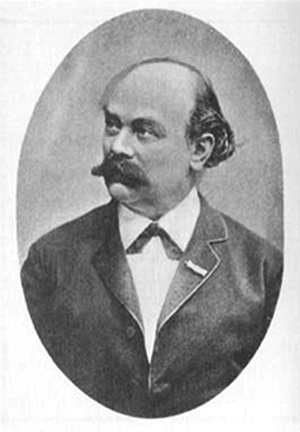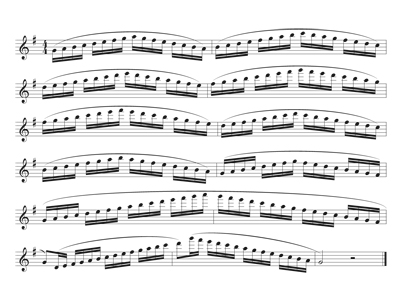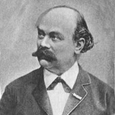Moving slightly when playing uses muscles in a way to prevent injury. This intelligent movement can be explored and practiced to define the phrasing gestures for the performer and the audience as discussed last month.
 Wilhelm Popp
Wilhelm Popp
Wilhelm Popp (1828-1903) was a German flutist and a prolific composer of virtuoso salon pieces. One of his cleverest compositions is Bagatelle for flute and piano. What is unusual about this piece is that was created to be performed by one player. The flute part is played by the flutist’s left hand and the piano part with his right hand. For pedagogues, the Flute School, Op. 205 is an excellent example of how technique was developed in 1873. It is also a good work with which to practice movement gestures
As you look over this example, notice the similarity of Popp’s first seven measures to Exercise No. 4 from the 17 Big Daily Exercises by Taffanel et Gaubert (1923). What we can deduce from this similarity is that this exercise was a standard scale pattern for flutists from at least 1873. Many flutists have questioned the mode usage in the minor portion of Taffanel et Gaubert’s exercise. Popp’s minor scale patterns employ the melodic minor scale only. Since the Taffanel et Gaubert minor patterns are not consistent through each key, it may be that this change of mode was an engraving error rather than a philosophical statement. The other thing of interest is that at the end of each scale pattern Popp employs either a 15-note rendition of the scale or arpeggiated passages in the tonic or dominant keys. To examine Popp’s complete 24 scale study, see www.imslp.org.
Flute School, Op. 205, Exercise #3

Down/Up
The down/up phrasing gesture is the one flutists naturally do when cueing another instrumentalist to begin playing. When cueing, notice how the flute remains firmly in the chin while the chest and arms lift as a unit as the air enters the lungs. The intake of the air is done on the upbeat or preparation beat with the flute lifting slightly and then on the exhale the flute returns to the starting position. The down/up gesture is indicated by the down bow icon used in string performance. In music the down/up gesture is used when the musical idea begins on the beat. Each chunk of notes is played slurred and on one blow of air. Be sure students move simply following the down bow icons and do not pulse with the air or the end of the flute.
Have students practice each of the following examples in a mirror. The movement should be simple and clear while moving in a straight line from down to up. At first the movement should cover four to six inches, but eventually the movement will be quite small. Notice the down bow icon at the beginning of each example. In the future they will mark this icon in the music to remind them of how to move. The first note is the strongest or loudest (mf) and each note in succession becomes softer. Release the tension in the hands at the end of each chunk and take a breath in the rest. This type of breathing is called panting. Continued panting separates the vocal folds (opens the throat) which improves tone quality. Students should practice gesturing by four notes for several weeks or until becomes automatic.
.jpg)
Once students can easily perform this gesture by four notes, repeat playing by eight notes. Once again, check for clarity of movement. The end of the flute moves from down to up, in a straight line and on one blow of air. To rid extraneous movement, have flutists visualize a piece of chalk taped to the end of the flute. Then when doing the gesture, they should envision drawing an upward straight line as if on a black board. The first note is the loudest (mf) and each note in succession becomes softer. Students should practice gesturing by eight notes for several weeks or until it becomes automatic.
.jpg)
Gesturing by measure or sixteen notes offers a specific problem that most flutists encounter when practicing these movements. Notice the scale passage arches with the top A before descending. It is at the top A that flutists want to return the flute to the down position rather than keeping the gesture going on up. Many flutists have developed the tendency of moving the end of the flute in conjunction with the direction of the notes. This movement destroys the musical arch of the measure. Learning to play these sixteen notes on one up gesture improves technique almost immediately. The secret to developing a great technique is to place more notes on one gesture. If the end of the flute moves randomly or by too small a number of notes, the music sounds plodding, and the fingers are heavy. Practice gesturing by sixteenth notes until it becomes automatic.
.jpg)
Practice Popp’s scale pattern to explore gesturing by groups of varying lengths. Some patterns to try:
• Chunk by eight notes rest, eight notes rest, and then sixteen notes rest.
• Chunk by one measure rest, one measure rest, and then two measures rest.
• Create as many patterns as you can. The final goal is to play the entire key of G on one gesture and breath.
• Practice in the mirror paying careful attention to keeping the movement of the end of the flute concise and clear. Eventually the movement will be quite small and the musical effect will be one glorious phrase.
Other Options
Once these exercises can be performed naturally, apply these concepts to etudes, repertoire, and excerpts. In Joachim Andersen’s 24 Progressive Studies for the Flute, Op. 33 these practice strategies work well in nos. 1, 4, 7, 12, 15, 19, and 21. For exercises employing six notes to a beat (nos. 3, 5, 8, 9, 11, 13, and 16), gesture by beat and then by measure. In the Mozart flute concertos, practice all sixteenth-note passages following these steps. Not only will the notes flow well, but the virtuosic elements of the passages become simple.






